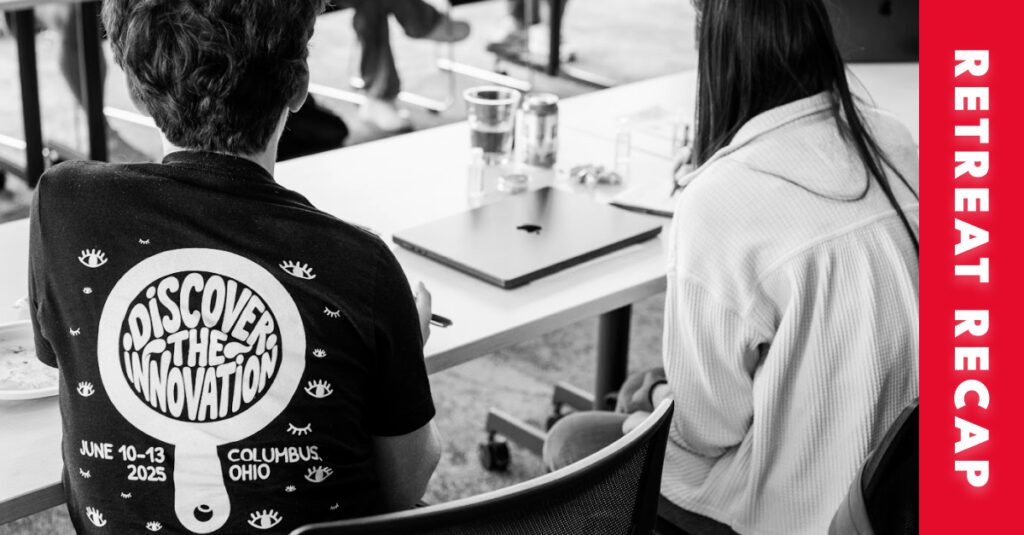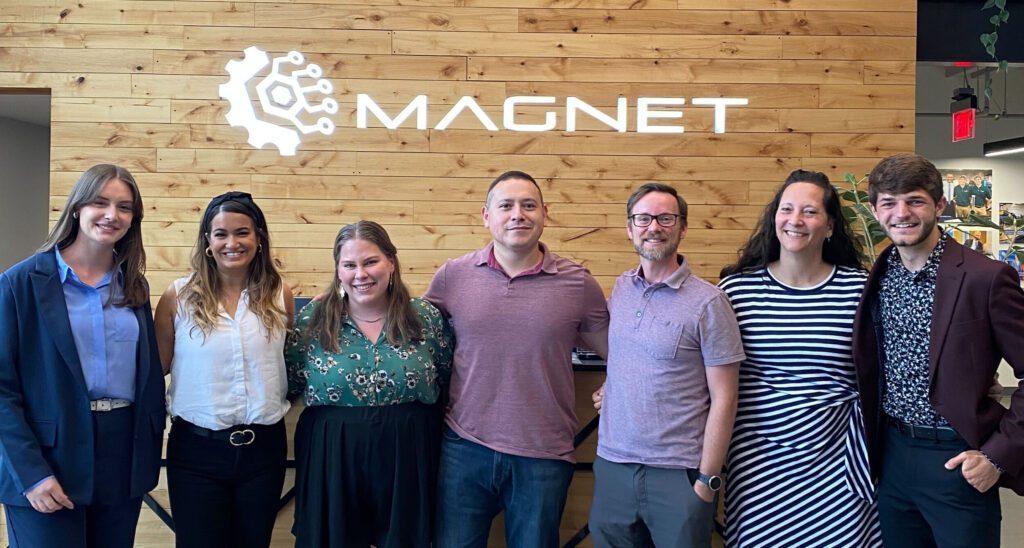Buckeye Innovation’s developers play a pivotal role in website redesigns. Whether it be troubleshooting, creating custom solutions, or launching, their collaborative efforts with our content strategy, design, and site building teams ensure the site gets off the ground and does exactly what it needs to do for our clients. We spoke with our lead software engineers, Andrew Godby and Scott Brady, and director of engineering Oscar Aguilar to find out more about what our development team does during a site redesign.
When looking at a website redesign, what role does development typically play?
Andrew G.
To start, we follow the guidelines of branding requirements and what the designers have created. While following these two items, we pay close attention to the bigger picture of how the app or site is working from all levels, ie: docker, server, application.
It’s also important to use good practice when coding! Making code readable is preferred over writing comments explaining what something does. And using the knowledge we have, we make suggestions to improve the site while staying inside the constraints of branding and mockups, and/or wireframes.
Scott
It really depends on the type of website that is being redesigned. If the website is primarily a marketing website on some sort of a CMS (like WordPress), then development is typically brought in to help meet any client goals that cannot be met using the CMS tools alone. That might look like adding custom code for styling, integrating with some 3rd party service, or building custom sections of web pages.
If the website is something more similar to a web application, then development will usually help the client strategize what features will stay the same, be added, be removed, or changed from the original design. Development will also typically give feedback on different wireframes and mockups, as well as implement those wireframes and mockups.
Oscar
For the most part, the dev team plays a support role to setup the underlying infrastructure of the website, help configure and setup a fresh or existing CMS (i.e. WordPress, Shopify, etc.), and consult with options for what can or can’t be done with the tools the CMS system has to offer (i.e. Elementor). In some cases, the dev team will be pulled in to provide custom components if CMS tools are unable to meet a specific requirement.
How does development collaborate with the other areas, like design, content, and site building?
Andrew G.
All the team pods should work as a well-oiled machine. Each pod has a specific role to perform and communication is the glue to hold everything together. For CMS sites like WordPress, the engineering team supports by assisting with tasks that present challenges to site building and design teams. Offering recommendations and opinions regarding more technical aspects of the redesign process is often welcomed and quite helpful. The goal is not to inhibit the creativity of the other team members, but rather assist them by empowering everyone with your own personal experience and skills.
Scott
Typically development is involved in helping form requirements before wireframes and mockups are created and then gives feedback when wireframes and mockups are created. With content-heavy sites, development might help implement the content and copy or provide tools to enter the content in. Development is typically brought in with site building when the specific site-builder cannot meet the needs of the client. We’ll ask questions like:
- What would make this easier to read?
- How can things be condensed while still getting the message?
- How can we restructure the proposal to make it more logical and flow smoothly?
- Are there any technical terms or jargon that can be simplified or explained more clearly?
- What kinds of visuals can we use?
Oscar
There are typically a series of hand-offs throughout the project. In the early stages, content, design, site-building, and developers collaborate to define requirements from strategy and architecture, identify what can be done out-of-the-box and what will need to be custom components, and any potential areas that might require more capacity from any given discipline. Throughout the project, the build and design team may identify challenges that may go beyond the limits of the CMS system. So a developer is looped in to evaluate the situation and provide an estimate for a custom built solution. During this time, a hand-off session occurs between designers and content strategists to describe the requirements of the component.
What’s the difference between site building and development?
Andrew G.
In my opinion, site building is using some type of CMS system to create website pages/blogs/components using editors and/or builders such as Elementor, Shopify, Drupal and others.
Development is the process of utilizing code to solve problems such as creating and developing new features, modifying existing functionality, etc. (C#, PHP, Docker, Python, and others).
Scott
With the way that we typically think about it at Buckeye, site-building is using no-code or low-code solutions to create pages on a website. These are typically drag and drop (or WYSIWYG) editors that need little or no programming experience. Development is when sites are created using code.
Site builders are preferred when the client wants to be able to take over managing the content for a site. But custom development is usually preferred when there is a lot of custom functionality needed in a site. Typically both methods can be used on the same site.
Oscar
This can be open to interpretation, but generally a Web Designer (what we call site builder) is a professional well-versed in design and website management that is able to draft, revise, and build landing pages for clients, including entire websites. This person may or may not know how to write code. But they generally have experience with hosting platforms that provide solutions for website hosting without developer experience. In most cases, Web Designers make use of CMS systems like WordPress, Wix, Shopify, etc. to create landing pages without code.
A Web Developer is generally expected to be able to do the same as a Web Designer, but with less expectation on the design aspect and more responsibilities for coding websites, web applications, and managing web solutions (hosting, server management, networking, etc.). At Buckeye, we make the use of the Software Engineer role to make this distinction more clear so that when someone applies for this role, there is no confusion that coding is expected.
Coding websites and web apps has a couple of obvious pros and cons. Pro: Ability to implement unlimited solutions, only constrained by time, budget, and expertise. Con: Generally more time and effort than a CMS system, especially when doing trivial things.
What does your process look like? And what’s your favorite part?
Andrew G.
My process really begins with listening to clients. To me, this is anyone that has the vision for what we are building. It’s my job to really understand what they want, and use my knowledge to build exactly what they are envisioning. My favorite part is planning and getting started in the early stages of product development. This is where I can really see the excitement in the client during this phase and it truly motivates me.
Scott
During a redesign, I typically like to talk with the client about their goals and the “why” behind the redesign. It’s easy to get so focused on redesigning a site that you forget the goals as to why it’s actually happening in the first place. I’ll then help form the requirements for the redesign – especially as it relates to the functionality needed – and then I’ll help pass all of that off to Design and Content. Once a wireframe / mockup / content recommendations are ready, I’ll provide feedback. I’ll then help wherever needed, whether that’s actually building out the site or helping support whoever is. Probably my favorite part is figuring out the goals behind the redesign and making sure that we hit those goals.
Oscar
I like the very early stages of a project, strategy and architecture. This part defines the product roadmap and we get creative with timelines, tradeoffs, priorities, etc. The initial setup and configuration which can be a challenge but is very fun to do. I typically work best when asked to come in and help solve a challenge and don’t usually need to sit in on every meeting if I’m working as a project team member. But as a project lead or implementation lead, I enjoy helping solve challenging problems and brainstorming with the team.
What are some of your favorite things to troubleshoot during a redesign?
Andrew G.
Troubleshooting in general isn’t always exciting. But some tasks can be less challenging than others. Those tasks include styling changes, or some javascript changes to bring interactivity to the website. I would prefer sprucing up a site with CSS/JS than resolving bugs. My advice here would be to triple check everything so you don’t have anything to troubleshoot later! 🙂
Scott
Anything that causes me to learn a new skill. We work on all sorts of different projects and use all sorts of different technologies. Naturally that means that I’ll run into things that I’ve never had to do before. That’s always an exciting opportunity to learn something new.
Oscar
I enjoy the infrastructure and networking part of web development. I like figuring out how servers talk to each other, security rules to prevent attacks, and domain management. When these things go wrong they’re usually the most challenging parts of a project that not many people have experience or patience to deal with. So jumping in to solve the hardest problems makes me feel like I made a significant contribution towards the success of the project.
Once a project is completed, then what? Is there opportunity for development to continue to be involved in support?
Andrew G.
This is where one of our core values really shines. At Buckeye Innovation, we are strategic partners. We look out for you on several different levels. From the dev side of things, we keep an eye on your hosting, stay on top of app upgrades, and even look for solutions to existing issues preemptively. Being proactive is a great way to give our clients an advantage over the competition. It’s an exciting process to be involved with.
Scott
Of course! There are multiple ways that we could help support the project after it is launched. We monitor site uptime, keep it up to date, and help troubleshoot any bugs or issues that come up. We also love to partner with our clients to figure out what the next step is for their site.
Oscar
Absolutely, there is a lot of opportunity surrounding performance and security. But this can be hard to sell for low budget clients that don’t really care too much about a 5 second speed difference or might not have sensitive data in their websites or applications. I’d love to figure out how we can find clients with these types of needs, perhaps a government agency or medical institution that has very specific performance and security requirements.
Anything else you want to add about development?
Oscar
It’s amazing! But only a piece of the puzzle. Design, Content, and Engineering all form part of a whole process that is designed to give clients a complete web solution. It’s important that all disciplines come together as part of the project team for every project to ensure our clients get the best Buckeye has to offer.






